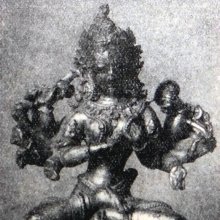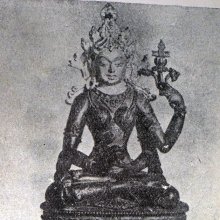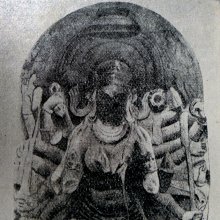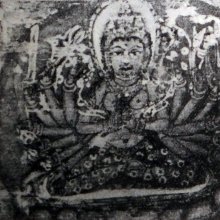Manjushrimulakalpa, Mañjuśrīmūlakalpa, Manjushri-mulakalpa: 1 definition
Introduction:
Manjushrimulakalpa means something in Buddhism, Pali. If you want to know the exact meaning, history, etymology or English translation of this term then check out the descriptions on this page. Add your comment or reference to a book if you want to contribute to this summary article.
The Sanskrit term Mañjuśrīmūlakalpa can be transliterated into English as Manjusrimulakalpa or Manjushrimulakalpa, using the IAST transliteration scheme (?).
Images (photo gallery)
In Buddhism
Tibetan Buddhism (Vajrayana or tantric Buddhism)
Source: archive.org: The Indian Buddhist IconographyMañjuśrīmūlakalpa (मञ्जुश्रीमूलकल्प) forms a part of the ancient Vaipulyasūtras of Mahāyāna and is decidedly the earliest work of Mantrayana at present available. It is written in the Saṅgīti style in prose and in verse, and in an archaic style closely resembling the Gāthā style, and is written throughout in what is called the Mixed Sanskrit.
The Mañjuśrīmūlakalpa deals with the formulae and practices which lead both to meterial prosperity and spiritual regeneration, and belongs to the early centuries A. D. but decidedly after the time of the composition of the Amitāyus-sūtra or the Sukhāvatī-vyūha which ushered in the conception of Amitābha and Avalokiteśvara for the first time in Mahāyāna.
The Mantras of some of the Dhyāni Buddhas are indeed to be found in the Mañjuśrīmūlakalpa although not exactly in the same meaning and form as in the later Guhyasamāja. The Mañjuśrīmūlakalpa further apeaks of Mantrayana but it does not refer to Vajrayāna which is mentioned for the first time in the Guhyasamāja the Tantra of Secret Communion. Under the circumstances it is possible to call the Mañjuśrīmūlakalpa as one of the earliest Mahāyāna Sūtra works on which perhaps is based the outward foundation of the Vajrayāna system.

Tibetan Buddhism includes schools such as Nyingma, Kadampa, Kagyu and Gelug. Their primary canon of literature is divided in two broad categories: The Kangyur, which consists of Buddha’s words, and the Tengyur, which includes commentaries from various sources. Esotericism and tantra techniques (vajrayāna) are collected indepently.
See also (Relevant definitions)
Partial matches: Manjushri.
Full-text (+2015): Kamarupa, Sughora, Uparishta, Grasana, Pilu, Kshitigarbha, Bhishana, Shvetabhadra, Vimalagati, Upapilu, Supilu, Kulishika, Sitaketu, Lokagati, Andharasundari, Akshayamati, Rahu, Sudanta, Ghanta, Vairocanagarbha.
Relevant text
Search found 10 books and stories containing Manjushrimulakalpa, Mañjuśrīmūlakalpa, Manjushri-mulakalpa, Mañjuśrī-mūlakalpa, Manjusrimulakalpa, Manjusri-mulakalpa; (plurals include: Manjushrimulakalpas, Mañjuśrīmūlakalpas, mulakalpas, mūlakalpas, Manjusrimulakalpas). You can also click to the full overview containing English textual excerpts. Below are direct links for the most relevant articles:
Settlement in Early Historic Ganga Plain (by Chirantani Das)
Part 2 - Buildings of Rājagṛha < [Chapter II - Origin and Function of Rājagṛha as the seat of Monarchy]
Sripura (Archaeological Survey) (by Bikash Chandra Pradhan)
Scultures of Manjusri < [Chapter 3 - Sculptural Programme]
Tibet (Myth, Religion and History) (by Tsewang Gyalpo Arya)
4. Justification of the Monkey Myth < [Chapter 1 - Early Tibetan Origin Myth]
Stupas in Orissa (Study) (by Meenakshi Chauley)
Tantric Buddhism in Orissa (Introduction) < [Chapter 2]
The Mahavastu (great story) (by J. J. Jones)
Blue Annals (deb-ther sngon-po) (by George N. Roerich)
Chapter 9 - The Tibetan emperors prophesied in the Mūlatantra < [Book 1 - The beginning of the story of the Doctrine]
Chapter 10 - Imperial lines of Tibet, China, Hor, etc. < [Book 1 - The beginning of the story of the Doctrine]



